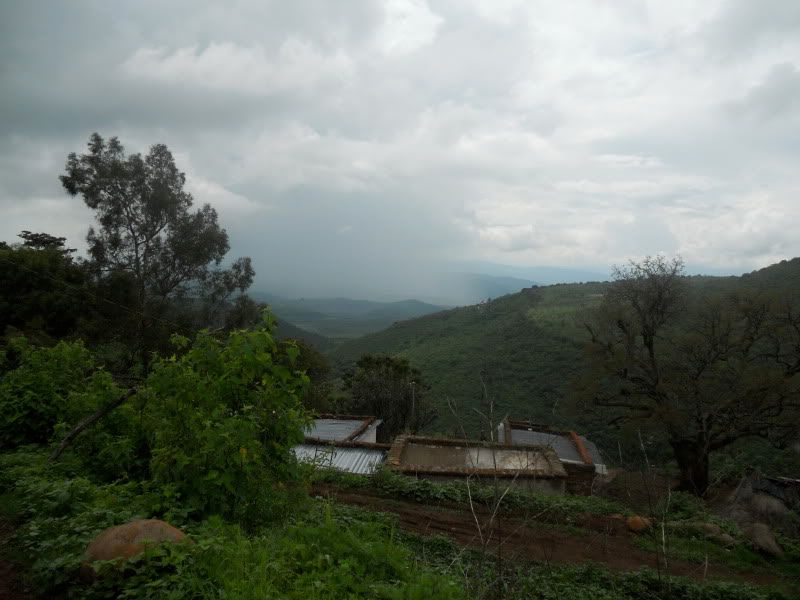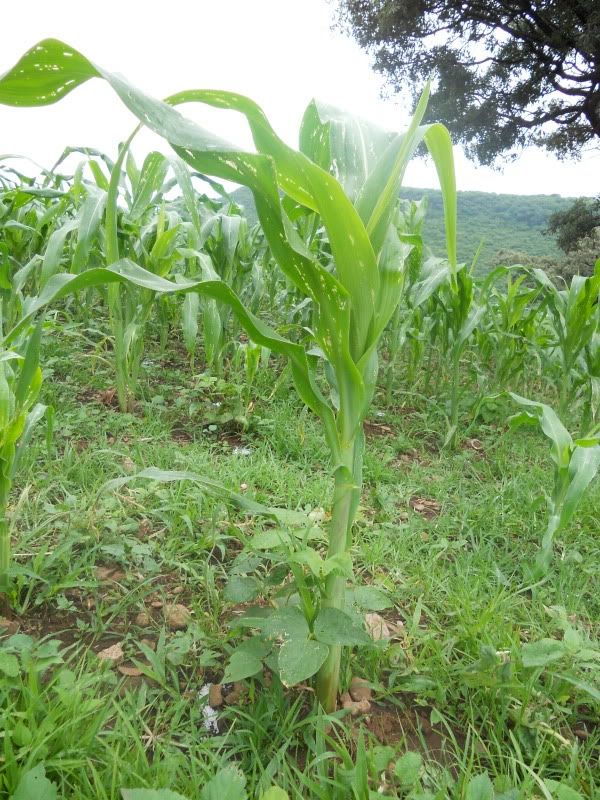
The view from the rancho
If reading about the people I've visited inspires you to help, you can donate to the Center for Farmworker Families. Every penny given goes directly to these families for clothes, shoes, food, school supplies, and more.
Mexico is organized into municipalities, which each include a central town or city as well as the outlying rural areas. We visited five "ranchos" (tiny villages) within the municipality of Cuquio, which you can see on the map here:

Map of Cuquio's municipality. Out of all of these zillions of ranchos, we only helped five. How many other people are in need, just in this one municipality?
On the map, you can hopefully see the various highlighted areas. The large highlighted spot in the middle is Cuquio itself. Each of the other highlighted areas are the ranchos. On the 8th day of the trip, we visited the northernmost rancho. Unlike the other ranchos, which were each about 30-40 minutes away, the road to this one took an hour and a half, almost entirely on dirt roads. Actually, on that particular day, they were mud roads. We made the drive in the back of two pickup trucks in the rain.

Piling into the truck for our trip. Notice the pirate pinata.

A view of Cuquio from just outside of town
After a long drive and a few moments when I thought our truck wouldn't make it, the truck stopped. Normally, we stopped in front of a house where a crowd of kids were anxiously awaiting us, but not this time. We parked in the middle of nowhere on a mountain. The rancho was only accessible on foot, and we had parked at the trailhead. Ann had warned us to wear pants and closed-toed shoes and this was why. Now she instructed us to follow the path all the way to the bottom. With the various suitcases, pinatas, and watermelons we were carrying, we were all grateful that the hike was down and not up.

A first view of the rancho, looking down on the roofs of the homes
About halfway along the trail, the kids found us and started eagerly hiking along with us and showing us where to go. A young boy noticed the soccer ball I was carrying, which I had bought at the tianguis (flea market) the day before to give away. "Futbol!" he said excitedly. I gave it to him. "Para ti," I said ("For you"). He didn't say much to me, and the ball disappeared soon after I gave it to him, but he hung around me all day with a smile wider than Texas. A member of our group noticed and said, "I think you've got a boyfriend."

The home of our hosts in the rancho

The side of the home and the bathroom, a composting toilet distributed by the municipality

Like each of the two homes we visited before, this house sported a plaque announcing that it had received a cement floor from the federal government recently. Before that it had a dirt floor.
Before long, we began our usual routine. First, we let the kids put our ailing pirate pinata out of its misery. Then cake, shoes, clothes, school supplies, etc, etc. My job this time around was handing out toothbrushes and toothpaste. First the kids, then the adults. I hit one difficult moment when I was handing the toothbrushes out to the adults and the next person in the row was an elderly lady with nearly no teeth. Does she need a toothbrush or is it too little too late? I didn't want to insult her, so I gave her one.
This time, our party included a new element: pictures! As you can imagine, the people we were visiting don't take too many pictures. Often, the kids didn't even get the concept. We'd tell them to smile and count to three, and they'd look at us like we were aliens. Ann had visited this rancho and taken pictures before, so this time she brought a set of 4x6 prints to give out. The pictures were a huge hit. I wouldn't be surprised if these are the only pictures of themselves and their children the people in the rancho have.
When I wasn't handing out toothbrushes and soccer balls, I was scoping out the corn. As usual, I observed intercropped corn, beans, and squash. This time, I noticed something that looked like salt next to each of the plants. Urea fertilizer. The good news, however, is that this rancho still plants exclusively maiz criollo, instead of the hybrid, Green Revolution seeds. Ann Lopez, who hopes that this village will continue to plant maiz criollo, brought along corn expert Juan Alba for this trip and he spent a while chatting with our hosts about corn and agronomy.

Corn with beans

Urea fertilizer

The cornfield in front of the home we visited. Notice the slight slope.
The home next door to the one we visited was located on a steep hillside, entirely surrounded by its cornfield. There was no way you could get a tractor on that slope. They likely did all of their farm labor by hand.

Home with cornfield on a slope
We took a quick hike down the mountain a bit to see where the families got their water from. They built a water collection tank where water accumulated, and then pumped that water to several homes. I don't think they had running water per se (and certainly no water heater and hot water coming out of the tap), but at least with the pump they didn't have to hike up and down the mountain every time they needed water.

The water supply
In addition to their cornfield, they also had a cow for milk, a donkey, and about eight hens and a rooster. I asked if they had any fruit trees and they gave me a long list: apple, peach (both yellow and white), mango, pomegranate, banana, capulin (related to cherries), lime, lemon, guava, mandarin, bitter orange, grapefruit, guamuchil, sapote, pitaya, tuna, and plums. Additionally, they had mesquite, nopales (prickly pear cactus, commonly eaten in Mexico), calabash gourds, and "fungus but not mushrooms" (I assume they were talking about huitlacoche, a corn fungus eaten in Mexico, which I would best describe as an acquired taste).

Chicken

More chickens
While I was taking my inventory of fruit trees, the rest of our group left for a hike. Our hosts had made us quite a bit of food, which we did not eat (I assume this executive decision was made by our group leaders due to fears of food poisoning), so when they wanted to take everyone on a hike, our group couldn't say no. We'd already offended them once.
When I peeked out from behind the house, there were no gringos left. "Everyone went home," my host told me. I panicked and began to run up the path, collecting my belongings as I went. Surely, they would count to make sure everyone was in the truck before they left, I thought. Then I stopped and turned around. "The police are still here!" I exclaimed. The police were our ride. No one went anywhere if they were still standing around. Everyone had a good laugh at my expense.
Speaking of the police, it was about this point in the trip that people began talking to the police and to others in town to get the scoop about local drug cartel action. Apparently, Cuquio is an oasis in between other municipalities that have experienced quite a bit of violence. I saw signs in Cuquio advocating staying drug free, and I even saw D.A.R.E. shirts. If I remember correctly, Ann told us that there was only one narco in the area that she knew of, and he was tolerated because he did things like pay for surgeries and other expensive medical care for those in need.
At any rate, there I was, stuck on a dramatically beautiful mountainside in rural Mexico, which really did seem like the edge of the world, alone with a few Mexican cops, some of the locals, and Juan Alba the corn expert. The man who had been telling me about his fruit trees spoke Spanish in a way that was more or less unintelligible to me and Juan (bless him) was translating his words into more understandable Spanish, well enough that we could all carry on a conversation.
We talked a lot about the benefits of growing food without chemicals and not contaminating the environment (a major concern among the Mexicans I spoke to who didn't use any pesticides). He ran over to his peach tree and eagerly brought back a handful of ripe peaches. "Here! Try it! A clean peach!" I did not want to try it. I love peaches and I was hungry, but did I really want to risk food poisoning for a peach?
There was no way out. No polite way out. I ate it. He gave me a second one, and then ran to get some more. I insisted that his peaches were delicious but I was full. I told him I would put the peaches in my purse to share with a friend, so the other Americans could try his delicious, clean peaches. I'm not sure if he bought it, but sooner or later, he dropped the subject and I stashed the peaches in my purse. (And fortunately, the peaches didn't make me sick.)
I continued to stand there until the group got back from the hike. The breathtaking scenery never got old. I can't imagine living there, on this untouched, gorgeous side of a mountain. The residents of the rancho know how beautiful their home is, as many of them asked me what I thought of it. One decided to play a joke on me, and when I replied "Muy bello," she answered, "Muy FEO???" ("Very UGLY??"). Nobody in their right mind could call this place ugly.


One more look at that beautiful view
At last, when our group returned from their hike, it was time to go. Our hosts guided us up a steep path that served as a shortcut to our trucks. When we reached the top of the path, we had one last item of business. Ann had arranged to have a minivan donated to the town because the children had no way to get to school otherwise. Through her efforts, now the town's children were able to have a chance at education and perhaps, hopefully, a better life. Before leaving, we needed to get a picture of the kids in front of their van, to send to the donor as a thank you.
What a day. We said our goodbyes, piled into our trucks, and made the cold, wet trip home.
No comments:
Post a Comment